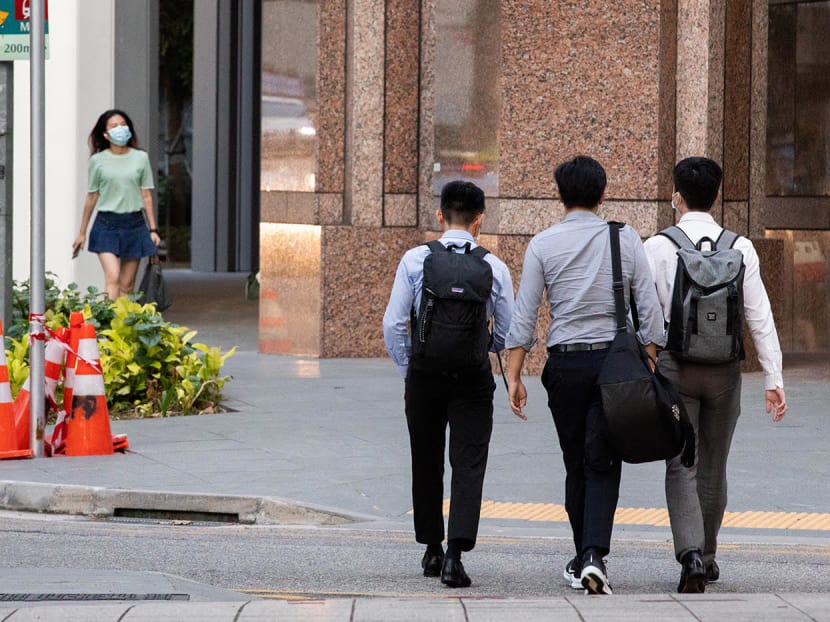Retrenchments jump by 35% in Q3, largely due to layoffs in tech sector: MOM
SINGAPORE — More workers were laid off in the third quarter of this year compared to the previous three months, and fewer retrenched workers found another job within six months.

- Retrenchments for the third quarter of 2022 rose to 1,120 from the 830 in the second
- The Ministry of Manpower said this is largely due to layoffs at technology firms
- Retrenchments in the information and communications sector went up from 110 in the second quarter to 460 in the third
- The sector's job vacancies remained high though, suggesting that layoffs were due to restructuring efforts, the ministry said
SINGAPORE — More workers were laid off in the third quarter of this year compared to the previous three months, and fewer retrenched workers found another job within six months.
The latest manpower data also showed that the lay-offs were fuelled largely by tech firms, even as vacancies in the sector remained high — a sign that the retrenchments may be a result of restructuring within the firms.
These were the key trends from the Labour Market Report released on Thursday (Dec 15) by the Ministry of Manpower (MOM), which showed layoffs jumping nearly 35 per cent — from a record low of 830 in the previous quarter to 1,120 in the third.
The report also showed that retrenched workers who found jobs in half a year dipped for a second quarter — from about 72 per cent in the first quarter to around 65 per cent in the third quarter.
Giving more details on retrenchments in the third quarter coming mainly from tech firms, MOM said that:
- The information and communications sector saw retrenchments increase from 110 in the previous quarter to 460 in the third quarter
- The typical profile of a retrenched worker for the third quarter matched that of the typical employee in this sector
- They were professionals, managers, executives and technicians (PMETs), degree holders, and were aged below 40
- Vacancies in the sector remained high, suggesting that the retrenchments resulted from restructuring efforts within the sector
WHY IT MATTERS
Last month, several Members of Parliament asked about the global tech layoffs affecting Singapore.
The questions came after a spate of retrenchments in recent months involving multinational tech giants with offices in Singapore, as companies such as Shopee, Meta and Twitter announced such moves.
In response, Manpower Minister Tan See Leng said that the Government had received a total of 1,270 retrenchment notices involving workers in Singapore from tech companies from July to mid-November 2022.
On Thursday, MOM said that the third quarter’s rate of re-entry into employment still remained above pre-Covid levels, with the same being said of the overall retrenchment numbers.
Retrenchments in other sectors, including accommodation and construction, stayed low as they maintained strong hiring this quarter.
Furthermore, the ministry said that total employment for the third quarter has expanded robustly to 75,900, compared to the previous quarter’s 66,500.
WHERE ARE THE JOBS?
Similar to past quarters, MOM said that the increase in employment for the third quarter was higher for non-residents (71,100) than residents (4,800).
Total and resident employment levels were 1.7 per cent and 4.4 per cent respectively above their pre-pandemic levels. However, non-resident employment remained 3.9 per cent below its pre-pandemic levels.
The increase in resident employment were led by financial services, professional services, and information and communications.
As for increases in non-resident employment, the majority came from the manufacturing and construction — sectors that are reliant on foreign workers.
MOM said that food-and-beverage services, as well as the arts, entertainment and recreation, saw a pick-up in non-resident employment.
It also said that the labour market tightness has eased:
- Total job vacancies declined for the second consecutive quarter with 108,200 vacancies in September, compared to 126,100 in June
- March saw a record high of 128,100 job vacancies
The bulk of the job vacancies in September were in:
- Manufacturing and construction
- Information & communications
- Financial services
- Professional services
- Health and social services
The ongoing recovery in domestic and tourism activities also contributed to strong manpower demand from consumer-facing and tourism-related sectors (17 per cent), including food-and-beverage services and wholesale and retail trade, MOM said.
WHAT NEXT?
Looking forward, the ministry expects employment growth in the fourth quarter to "remain robust, but uneven across sectors" because:
- Accommodation, as well as food-and-beverage services, will step up seasonal hiring for the festive season
- Outward-facing sectors such as manufacturing may experience a more subdued growth due to a more challenging economic climate
On unemployment, MOM said:
- Unemployment rates have remained around their pre-pandemic averages
- Overall, the percentage for the third quarter was 2 per cent
- For residents and citizens, it was 2.8 per cent and 3 per cent respectively
- The resident long-term unemployment rate (0.7 per cent) remained unchanged over the quarter in September, after returning to pre-Covid levels in June
- "Although the labour market continues to see improvement and labour demand remains robust, the uncertain global economic environment, higher global inflation, as well as geopolitical tensions, will weigh on the labour market going forward," MOM said








